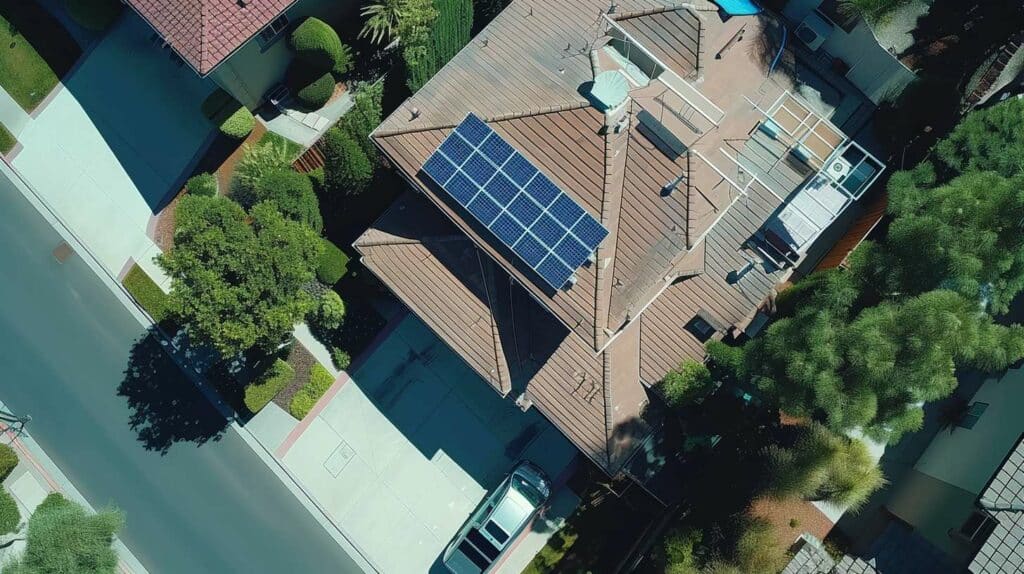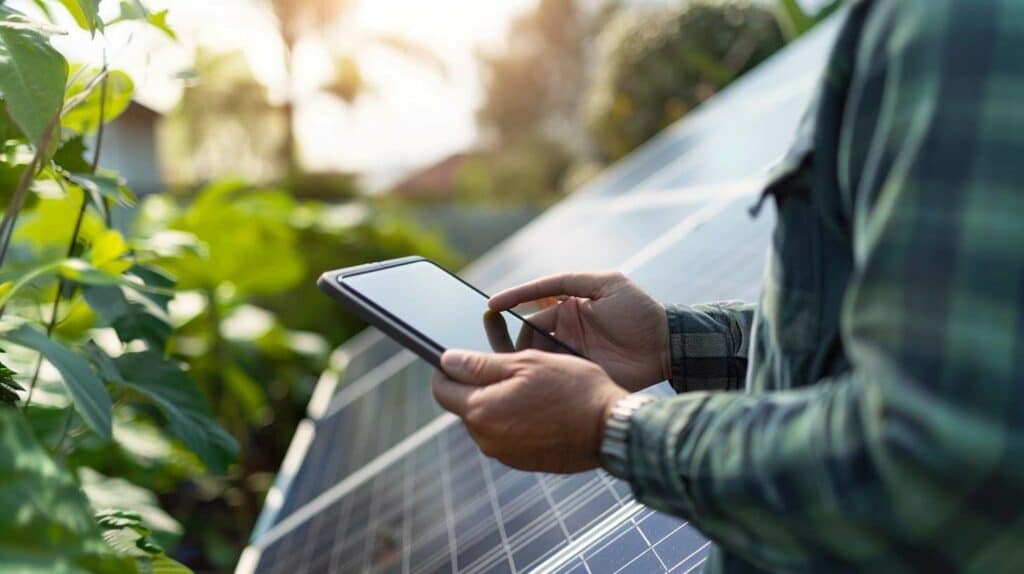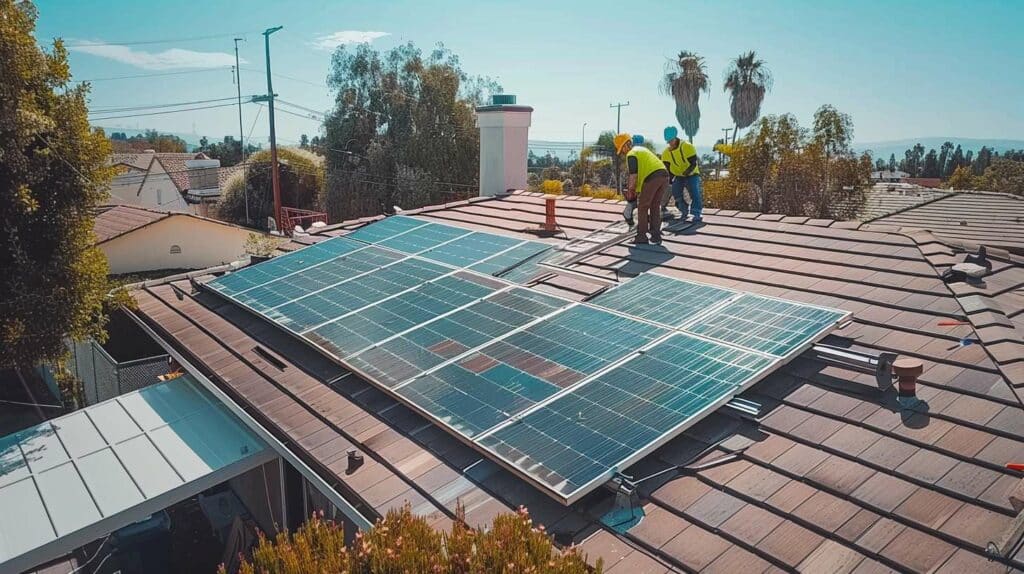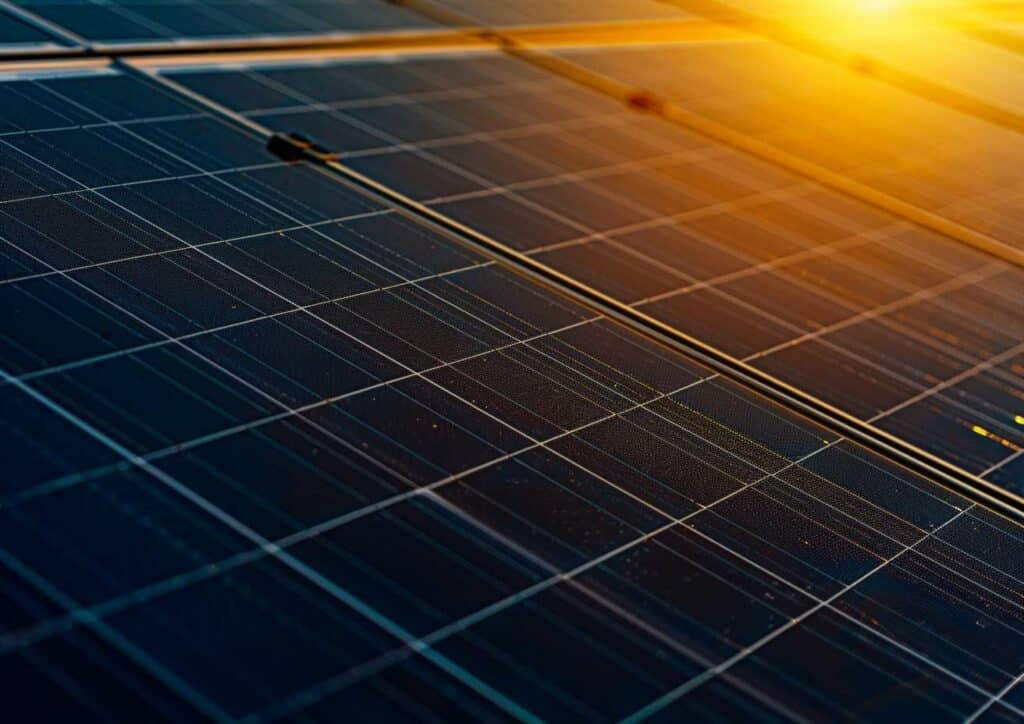With rising concerns about climate change and escalating energy costs, rooftop solar panels have become a popular choice for homeowners who are looking to reduce their carbon footprint and save on their electricity bills. Solar panels provide an eco-friendly alternative to traditional energy sources by converting direct sunlight into electricity.
In this article, we will walk you through installing solar panels on your roof from start to finish. We’ll break down the complexities and explain everything in simple terms. Whether you’re new to the world of solar energy or have some knowledge already, this article is designed to resonate with homeowners like you who are interested in home improvement and sustainability topics.
Understanding Solar Energy and its Benefits
Solar PV panels are composed of photovoltaic (PV) cells, which can convert sunlight into usable electricity. When sunlight hits these cells, it induces an electric field, freeing electrons and generating a flow of electric current. This process, known as the photovoltaic effect, forms the basis of solar energy production.
One of the most significant benefits of harnessing solar power is the potential for substantial cost savings. You can significantly reduce your reliance on traditional power sources and lower your monthly utility bills by generating your electricity. As a homeowner, you can generate clean, renewable energy while putting money back into your pockets.
Furthermore, solar panels contribute to a reduced carbon footprint. Traditional electricity production often relies on fossil fuel sources that generate harmful greenhouse gas emissions. By embracing solar energy, you actively participate in the global effort to combat climate change and transition to cleaner energy alternatives. Each kilowatt-hour of solar energy generated reduces the demand for conventional electricity, which helps mitigate the environmental impact associated with traditional energy production.
Assessing Suitability for Solar Panels
Before installing solar panels, assessing whether your home is suitable for this renewable energy solution is crucial. Understanding the factors that determine suitability and performing a solar site assessment can help optimize energy production and ensure the long-term success of your solar panel system.
The first consideration is your roof’s orientation and tilt angle. Ideally, solar panels perform best when they face south, as they receive the most sunlight throughout the day. However, east and west-facing roofs can also work well, although they may produce slightly less energy. Assessing the tilt angle of your roof is equally important since it affects how efficiently your panels capture sunlight. An optimal tilt angle is close to the latitude of your location.
Shading is another critical factor to evaluate. Trees, neighboring buildings, or other obstructions that cast shadows on your roof can significantly impact solar panel performance. It’s essential to consider potential shading sources throughout the day, accounting for seasonal variations. Maximum sun exposure ensures your solar panels produce electricity consistently and at their full potential.

Structural integrity is crucial to support the weight of solar panels and ensure their stability over time. The condition of your roof, including its age and materials, plays a vital role in determining its suitability for solar panel installation. A professional inspection can help assess whether any repairs or reinforcements are necessary to support the panels securely.
To determine the suitability of your home for solar panels and maximize energy production, it is advisable to conduct a comprehensive solar site assessment. Solar installers often perform this assessment, including detailed measurements, shading analysis, and system design considerations specific to your property. These steps ensure you make the most informed decisions regarding your solar energy investment.
Preparing for Installation
This section will discuss obtaining permits, analyzing your energy usage, conducting a roof assessment, and considering any necessary upgrades or repairs.
Obtaining Permits
Installing solar panels usually requires obtaining permits from your local government or homeowner’s association. These permits ensure that your installation adheres to safety regulations and building codes. Research the specific requirements in your area and contact the appropriate authorities to obtain the necessary permits.
Analyzing Energy Usage
Understanding your energy usage is crucial to determining the size and capacity of the solar panel system you need. Review your utility bills to gauge your average energy bill consumption and consider any changes in your usage patterns. This analysis will help determine the appropriate system size to meet your energy needs efficiently.
Conducting a Roof Assessment

Before installing solar panels, it’s essential to assess the condition of your roof. A qualified professional or solar installer can inspect your roof’s structural integrity, orientation, and shading factors. They will also evaluate its overall suitability for solar installation. This assessment ensures that your roof can support the weight of the panels and receives sufficient sunlight for optimal energy generation.
Upgrades or Repairs
If your roof requires repairs or upgrades, it’s best to address them before installing solar panels. This ensures a smooth installation process and prevents potential damage to your panels. Fixing leaks, reinforcing the roof structure if necessary, or replacing worn-out materials are essential steps before installation.
Completing these preparatory steps sets the stage for a successful solar panel installation.
The Solar Panel Installation Process
The installation of solar panels typically involves several key steps, ensuring a safe and efficient transition to clean energy.
Step 1: Site Preparation
Before the solar panel installation begins, the installation team will prepare the site and ensure everything is in order. This includes clearing the designated roof area of debris or obstacles hindering installation. The team will also make any necessary adjustments to the roof, such as reinforcing structures or fixing any potential issues. Safety measures, like using appropriate personal protective equipment, will be implemented to ensure a secure working environment.
Step 2: Mounting the Solar Panels
Once the site is prepared, securely mount the solar panels on your roof. Different mounting systems include flush mounts, ballasted mounts, and roof-integrated mounts. Flush mounts are the most common, directly attaching the panels to the roof surface. Ballasted mounts use weights to hold the panels in place, while roof-integrated mounts are integrated into the roof structure. The installation team will select the appropriate mounting system based on the roof type and design to maintain structural integrity and maximize solar energy production.
The team will secure each solar panel using specialized brackets and fasteners during mounting. These ensure a solid and reliable attachment, capable of withstanding wind, rain, and other weather conditions. Following industry best practices, the installation team will ensure your solar panels are securely in place and ready to harness the sun’s power.
Step 3: Electrical Wiring and Connection
Once the panels are installed, the next step involves electrical wiring and connecting the system to your home’s electrical grid. A solar panel system comprises different components, including solar panels, a charge controller, wiring, and inverters. Wiring connects the panels to the solar inverter, which converts the direct current (DC) generated by the panels into alternating current (AC) for your home.

During this stage, the installation team will carefully handle the electrical components and make the necessary connections. They’ll route the wiring, ensuring it is properly concealed and protected. Safety measures, including complying with electrical standards and regulations, will be followed to guarantee a safe and reliable electrical setup.
Step 4: Inverter Installation
Inverters play a vital role in the solar panel system by converting the DC electricity into AC electricity suitable for household appliances and the electrical grid. There are various types of inverters, such as strong, microinverters, and power optimizers. The installation team will select and install the appropriate type based on the specific requirements of your system.
During the inverter installation, the team will position the inverter in a suitable location, typically near your home’s electrical panel. They will carefully connect it to the solar panels, ensuring a proper electrical flow and functionality. The installation team will also integrate monitoring systems, enabling you to track the performance of your solar panel system and monitor energy production.
Step 5: System Testing and Activation:
After the physical installation, it’s time to thoroughly test and inspect the solar panel system. The installation team will perform various tests to ensure proper functionality, including checking electrical connections, measuring voltage levels, and verifying proper system integration. Additionally, they will inspect to ensure compliance with safety standards and regulations.
It will be activated once the system has passed all tests and inspections. The installation team will guide you through this process, helping you connect your solar panel system to the electrical grid. You’ll start generating clean, renewable energy and potentially reducing dependence on traditional power sources.
By following this meticulous installation process, your solar panel system will be poised to provide you with sustainable and cost-effective energy for years to come.
Maintenance and Understanding of System Performance
To ensure its long-term success and optimal performance, it’s crucial to understand how to maintain and monitor your system.
Ongoing Maintenance and Cleaning
Regular maintenance will help keep your solar panel system running smoothly. Here are some tips to remember:
Visual Inspections: Periodically inspect your solar panels for any signs of damage, debris buildup, or shading. Look for cracks, loose connections, or any obstructions affecting performance.
Cleaning: Keeping your solar panels clean is essential for optimal energy production. When necessary, gently hose them down or use a soft cloth or sponge to remove dust, dirt, and other debris. Avoid using abrasive materials or harsh chemicals that could scratch or damage the panels.
Trim Trees and Vegetation: If any trees or bushes cast shadows on your solar panels, consider trimming them to ensure maximum sun exposure. This will help maintain your system’s efficiency.
Professional Maintenance: It’s advisable to schedule periodic professional inspections to ensure your system is functioning correctly. A qualified solar provider can perform thorough checks, including checking wiring, monitoring system performance, and evaluating overall system health.
Monitoring and Interpreting System Performance

Understanding how to monitor and interpret your solar panel system’s performance allows you to gauge its efficiency and address any issues. Here are some key aspects to consider:
Monitoring Systems: Many solar panel systems have built-in monitoring systems that provide real-time data on energy production. Familiarize yourself with these monitoring tools and access the data regularly. It allows you to track daily, weekly, monthly, and annual energy production, helping you assess your system’s performance.
Energy Generation Patterns: Monitor the energy generation patterns of your solar panels to identify any abnormalities or changes in production. Seasonal variations, weather conditions, and shading can all influence energy generation, and monitoring helps identify potential performance issues or inefficiencies.
Understanding Performance Metrics: Take the time to understand performance metrics such as kilowatt-hours (kWh) generated, energy yield, and capacity factor. By analyzing these numbers, you can gain insights into your system’s efficiency and whether adjustments or maintenance might be needed.
Energy Consumption Analysis: Compare your solar panel system’s energy production to your household’s consumption. This analysis helps you understand how much of your electricity needs are met by solar energy and enables you to assess potential savings.
By following these maintenance tips and closely monitoring system performance, you can enjoy the full benefits of your solar panel system for years to come. Harnessing clean energy and reducing your carbon footprint will save money and contribute to a more sustainable future.
Financial Incentives and Return on Investment
Besides the environmental benefits, exploring the financial incentives and return on investment (ROI) associated with solar panel installations can further amplify their value.
- Federal Tax Credits: As a homeowner, you may be eligible for the Federal Solar Investment Tax Credit (ITC), which offers a credit of up to 26 percent (as of 2021) of your total solar panel system cost. This credit significantly reduces the upfront cost of solar panel installation and allows you to save thousands of dollars.
- State and Local Incentives: Many states and local governments offer additional financial incentives to promote renewable energy. These incentives may include rebates, grants, or performance-based incentives. Research your specific location to discover potential state and local programs that can further reduce the cost of your solar panel installation.
- Solar Renewable Energy Certificates (SRECs): In certain states, homeowners can earn SRECs by generating solar electricity. These certificates can be sold to a utility company, providing an additional revenue stream over time and further reducing the overall cost of your solar panel system.
- Cash Purchase: If you have the financial means, consider a direct cash purchase for your solar panel system. You can benefit from the quickest payback period and maximize your long-term savings by paying upfront.
- Solar Loans: Many financial institutions offer specific loans designed for solar panel installations. These loans often have favorable interest rates and flexible repayment terms, making them an accessible option for homeowners financing their solar investment.
- Power Purchase Agreements (PPAs) and Solar Leases: PPAs and solar leases are options where a third-party solar provider installs and owns the solar panel system on your roof. You agree to purchase the generated electricity at a predetermined rate. These options require minimal upfront costs but don’t provide direct system ownership.
Returns on Investment and Long-Term Savings
Solar panel installations can be a wise financial decision with excellent long-term returns. Factors influencing the payback period and savings include location, energy usage, system size, and incentive availability. On average, homeowners can expect a payback period of 6 to 10 years, with savings ranging from 20 to 70 percent on electricity bills over the system’s lifespan.
Furthermore, solar panel systems often increase the value of a home, providing a higher resale value if you decide to move in the future. Homeowners usually recover their initial investment and enjoy additional financial gains when selling their solar-powered homes.
By harnessing solar energy, you’ll reduce reliance on traditional energy sources, decrease utility bills, and contribute to a cleaner environment. It’s essential to consult with a qualified solar provider like WattLogic to assess your area’s specific financial benefits and incentives.
Conclusion
In conclusion, going solar reduces your carbon footprint, saves money on utility bills, and increases your home’s value.
Research reputable providers, get quotes, and consult with professionals who can guide you. WattLogic is a respected provider of solar panel installation services known for customizing energy solutions to meet individual needs and ensure maximum efficiency. By choosing WattLogic for your solar energy project, you can reduce your carbon footprint, save on utility bills, and increase the value of your home, all while receiving expert guidance and support.




